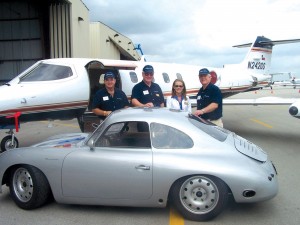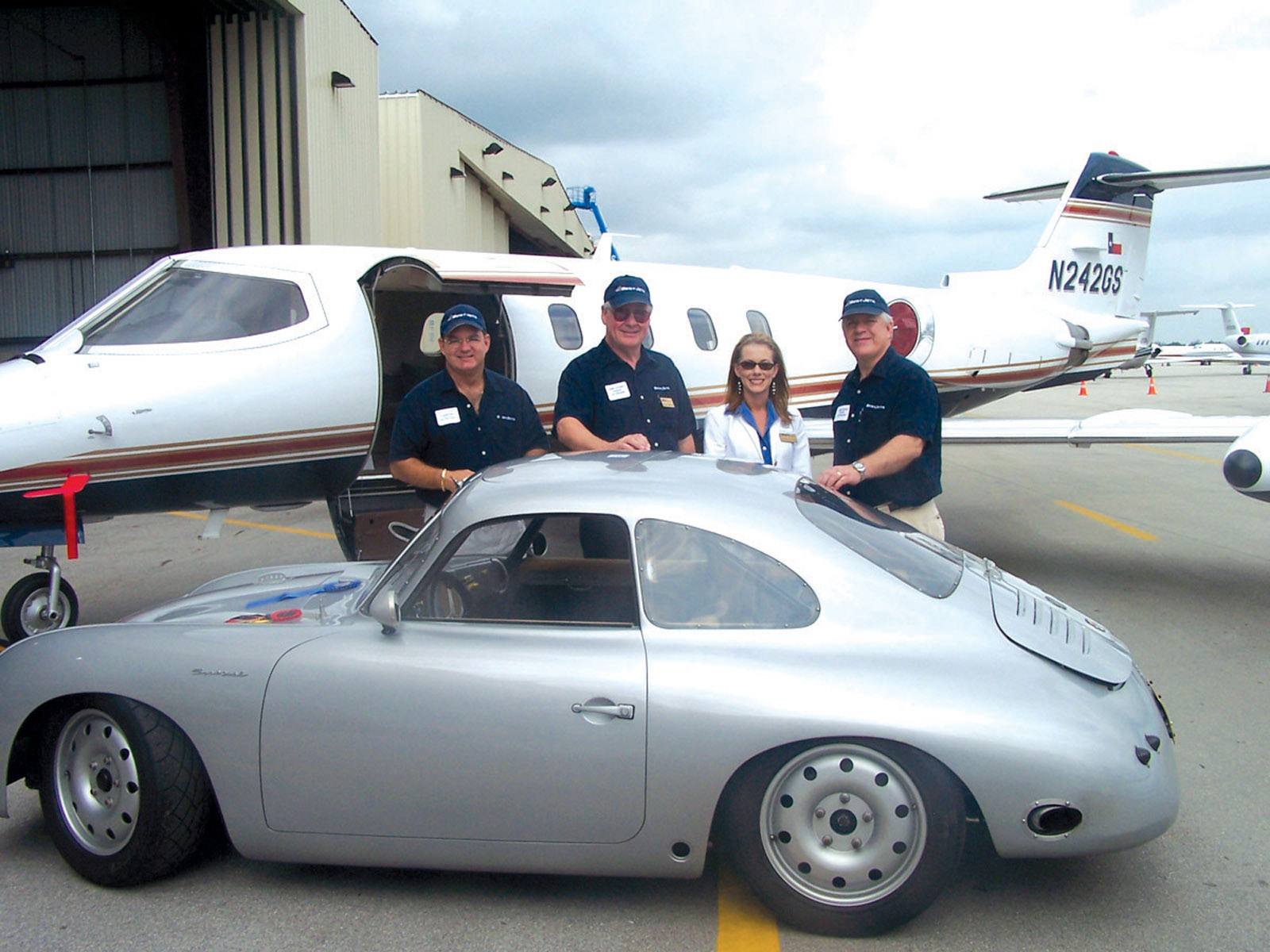By Lance Gurwell
Like most teenage boys, Floridian Jeff Hathorn developed his lust for speed when he was in high school. He loved fast cars, but his true desire was for speed on the water; he was a champion water skier until an injury ended his skiing career. Disappointed, but not defeated, he went on to college at the University of South Carolina and earned a degree in engineering. He also graduated from the Navy’s Reserve Officer Training Program.

Jeff Hathorn (far right) shows off his classic Porsche to L to R, Best AeroNet’s Steve Woolstenhulme, Roger Humiston and Chandra Stewart at the 2005 Florida Aviation & Business Jet Preview.
“My dad was a Navy pilot and I decided early on I wanted to be a Navy pilot, too,” Hathorn said. Conversing with the pilot/entrepreneur gives you the feeling there’s a 30-year-old “top gun” on the other end of the line. His tone of voice and enthusiasm belie his age. Now 59, his voice has the sound and energy of a young jet jockey, anxious for his next sortie.
Hathorn still loves the water. His home is on a private lake, where he maintains a fast boat and other assorted speedy water toys. Those toys include a rare tandem seat TBT-06 amphibian float plane he keeps in a small hangar on his beach. Both his sons and a number of their friends learned to fly in that plane.
“My oldest son is presently a Navy war zone experienced pilot who graduated first in flight training in his class,” Hathorn said. “He made his first solo in the amphibian plane. His solos were all on the water, without ever flying from land.”
Hathorn, who flew with a diplomatic passport, said much of his Navy flying from 1968 through 1971 remains classified. He saw considerable duty, flying missions “over unfriendly territories of high national interest.” Later, he was a captain and flying instructor for the now defunct Braniff Airlines.
He ended his commercial airline career as an international captain, flying B-767s for US Airways. His cockpit time includes aircraft of practically every type, and he holds instructor ratings for several of them. His flying plate remains full. He recently became captain of a Lear 20 for California-based Southfork Development Group, which acquires and develops waterfront properties.
Southfork is also acquiring a completely refurbished Lear 25, with less than 5,000 hours of flight time. Even though it was built in the 1980s, Hathorn considers that jet to be one of Lear’s best planes.
“It has been completely remanufactured and it has the latest avionics. It’s a dream to fly it, especially above 40,000 feet,” he enthused. “At that altitude, you encounter very little traffic. I’ve had it to 51,000 thousand.”
Hathorn is also still passionate about fast cars. He owns more than one, but the vehicle he’s focusing on now is a real classic. He acquired the 1955 Porsche 356 1500 Super Coupe a few years ago. Hathorn has heard plenty of stories about Porsche #54089, but it’s difficult to separate fact from folklore.
One chronicle claims that in the early 1970s, a farmer acquired the car and squirreled it away in his barn, planning to eventually restore it. By the mid 1990s, the car was still there. The farmer still planned to renovate it, although the resident mice and other vermin were in no hurry to see it go. However, along the way, the farmer had found himself a lady. It’s unclear whether an ultimatum was set; perhaps it was a prenuptial agreement or merely a suggestion, but the bride-to-be thought the farmer should get rid of the car because of his many other unfinished projects.
“Another account is that the farmer built a fake wall in the barn to hide the car from some hippies who planned to steal it,” Hathorn said. “Supposedly, he lit about 100 candles in the coupe to keep the moisture at bay whenever there was an extended wet spell.”
At any rate, the car escaped the hijacking hippies. The dusty sports car next belonged to a pair of legendary California hot rodders, Gary and Rod Emory. The father and son team was the first to break 200 miles per hour on the blinding-white Bonneville Salt Flats in their unique “Envelope Car.”
In the late 1990s, the Emorys were working on another restoration in their shop, Valley Custom, for Porsche’s 50th anniversary celebration in 1998 in Pebble Beach. “Porsche 1” had to be completed in time for the event, so the restoration of the other Porsche was delayed.
Hathorn first learned about the rare car in a magazine article published in 1999. He coveted the car then, but wanted it even more after reading about it again in 2003, in Excellence. When he inquired about the vehicle, the Emorys told him it would be quite a project.
Nevertheless, he purchased the car, and the Emorys agreed to help build it into a racer with one purpose: set a new speed record in the under 1.5 H/GT class. In five-plus years of work, few original parts on the car remain untouched under or on the sheet metal. A power plant built by renowned motor builder Dean Polopolous has replaced the car’s original engine. So important is the engine, specialists were tracked down to machine individual parts. For example, drag racing guru Henry Velasco machined the crankshaft from a proprietary kind of chromoly steel.
“We’re doing some dyno testing on the chassis right now,” Hathorn said. “But we think we can squeeze some more power out of the engine.”
Polopolous said the engine now produces 137 horsepower, but he believes 160 horsepower might be possible with some additional exhaust and carburetor work.
“That’s an amazing amount of power, more than 100 horsepower per liter,” Hathorn said.
An official with the Southern California Timing Association, which is in charge of maintaining speed records, said the current record of 145.76 was set at Bonneville in August 2003. Hathorn is confident his car will break the “World of Speed” record.
“Unofficially, we’ve run the car at 5.52 miles per hour over the existing speed record,” he said.
Despite extensive work to the exterior, the archetypal Porsche’s lines remain unchanged. In fact, after more than 50 years, the basic shape of the car remains the same, and it’s one of the most instantly recognizable automobile designs of all time.
Hathorn said about everything that can be done to make the car faster and more powerful has already been done. All that remains is to choose a location and select a driver. Hathorn may drive it himself, but he’s also considering several other drivers.
“Rod Emory is certainly a consideration and overly qualified, if he’s willing,” Hathorn said.
Olympic Gold Medalist Bruce Jenner is a possibility, as is Connie Tobias, a fellow racer and US Airways pilot who made history in January 2004 when she piloted a 1903 Wright Flyer replica 150 feet. If they attempt to break the speed record at the famous Bonneville Salt Flats in Utah, they’ll have to wait until September, when the annual “World of Speed” is held. However, a record attempt could be made at several other locations, including dry lakebeds in California, and deserted runways on the East Coast.
Meanwhile, Hathorn is a lot like the farmer who once owned the car: he’s lined up many other projects. He recently signed on as chief pilot for California-based Southfork Development Group, which acquires and develops waterfront properties, and those flying responsibilities have cut into his racing hobby.
Even so, when the time is right, Hathorn is going to find the time to send his Porsche in search of the record.
“I’m confident the team building this car is going to give us everything we need to hit the mark,” he said.











